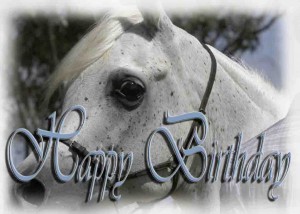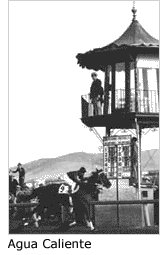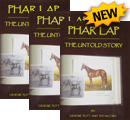HAPPY BIRTHDAY TO ALL OUR WONDERFUL HORSES…
In Australia, Monday 1st August 2011 is every horses’ Birthday.This is a perfect day to remember ‘Big Red’ better known as Phar Lap. Phar Lap (1926–1932) was a champion thoroughbred racehorse whose achievements captured the public’s imagination during the early years of the Great Depression.
All thoroughbreds have the same birthday so that their ages can be standardized for comparison. In the Northern hemisphere all Thoroughbreds celebrate their birthday on the same date, January 1 , and for us here in the Southern, Australia it is August 1st.
THE PHAR LAP STORY
The ‘Red Giant’ who lapped them all…. www.pharlap.com.au
Foaled in New Zealand, and brought to Australia, Phar Lap dominated Australian racing during a distinguished career, winning a Melbourne Cup, two Cox Plates and 19 other weight for age races. He then won the Agua Caliente Handicap in Tijuana, Mexico in track-record time in his final race. After a sudden and mysterious illness, Phar Lap died in 1932. At the time, he was the third highest stakes-winner in the world. His mounted hide is displayed at the Melbourne Museum, his skeleton at Museum of New Zealand Te Papa Tongarewa and his heart at the National Museum of Australia in Canberra.
Phar Lap the horse we all love…
Phar Lap, a New Zealand-bred horse, remains an enduring institution of the Australasian turf.
He also achieved world fame after winning the Agua Caliente Handicap near Tijuana in Mexico to take his race record to an amazing 37 wins, two seconds and three thirds in 51 starts.
Bought for only 160 guineas (approx. US $130) Phar Lap was unbeaten at 1¼ miles (seven wins); 1½¸ miles (eight wins); 1¾ miles (three wins) and 2¼ miles (one win). He also won four races from six starts at two miles, including the 1930 Melbourne Cup with 15 lb. (6.8 kg.) more than weight-for-age.
Phar Lap started favourite in three successive Melbourne Cups, the only horse in the long history of Australia’s most famous race accorded that distinction. Now, amazing photographs of each of his wins have been published for the first time in The Phar Lap Collection. This magnificent publication, printed on art-quality paper, comes with its own presentation case.
Phar Lap became the most public horse of all time, not entirely because he was so sublime. Drama, controversy, wickedness and savage cruelty rode with the big, gentle chestnut from barrier to box. Criminals in Melbourne tried to shoot him on the Saturday morning before his 1930 Melbourne Cup win and finally, tragically, he suffered an agonising death in mysterious circumstances in California, USA, on April 5, 1932, when he was only a five-year-old. Although all manner of theories abound about it, the cause of Phar Lap’s death has never been clearly defined.
Known variously as “Big Red” or the “Red Terror”, Phar Lap was a big, plain looking, cheap-priced underdog, trained by Harry Telford, an impecunious victim of the Depression. Telford leased the horse from American owner Mr David Davis, or more appropriately, considering it was an era when few people owned much and the term “rent” was the operative word, Telford “rented” Phar Lap. Telford and his horse were seen as battlers, like the majority, at a time when tens of thousands regularly stood in dole queues, no doubt discussing the triumphs of Phar Lap as a relief from their despair. The clearest illustration of Phar Lap’s greatness was his victory at Agua Caliente on March 20, 1932. It wasn’t so much the win, but the way he achieved it. Phar Lap travelled by ship across the Pacific arriving in cold conditions in San Francisco; he then had an 800 km. road trip to Tijuana where conditions were boiling hot, none of which was conducive to having a horse at his peak.
Even though he had not raced since carrying 10st 10lb. (68 kg.) when unplaced in the Melbourne Cup the previous November, Phar Lap had to carry 9 st. 3 lb. (58.5 kg.) against some of the best horses in America and he was racing on dirt for the first time. On arrival he was starting to grow his winter coat; his body clock preparing for an Australian Winter – not a Mexican Summer. A further complication occurred when he suffered a painful injury to his heel, which usually spells the end of any training program. Yet another negative factor was his rider, Billy Elliot. Capable Melbourne lightweight that he was, Elliot had no experience in the “big time” of America or on dirt tracks. Because of the hoof injury, Phar Lap’s task looked even tougher when he was forced to wear heavy bar shoes for the first time.
Winning W.S.Coc Plate 1930
History was also foreboding. Eight years earlier, the 1923 English Derby winner, Papyrus, who defeated Pharos (who sired turf immortals Nearco and Pharis) went to New York for a special match race against America’s best horse, Zev, at Belmont Park. Papyrus, unable to cope with the dirt track and climatic changes, was annihilated by five lengths. Many American racing aficionados, remembering Papyrus, expected Phar Lap to suffer the same fate in 1932. How wrong they were! Papyrus was a topliner, but Phar Lap was something different again. He circled the field from last place to win easily by two lengths in track record time of 2:2.8, clipping .2 seconds from the previous best time.
His trainer, Tommy Woodcock, said after Agua Caliente “Americans called him the “Wonder Horse”, the “Red Terror” and other names that lifted him high above the level of other champions, but those closely connected with Phar Lap did not employ anything but names of endearment. To Jim Pike (regular jockey) he was “Old Boy”; to part-owner Mr D. J. Davis, he was the “Big Fellow”, but to Harry Telford and me he was just plain ‘Bobby’.”
The racing fraternity at large knew him simply as Phar Lap, champion of the world.
Phar Lap – The Untold Story
$30.00 – Click here www.pharlap.com.au






Leave a Reply